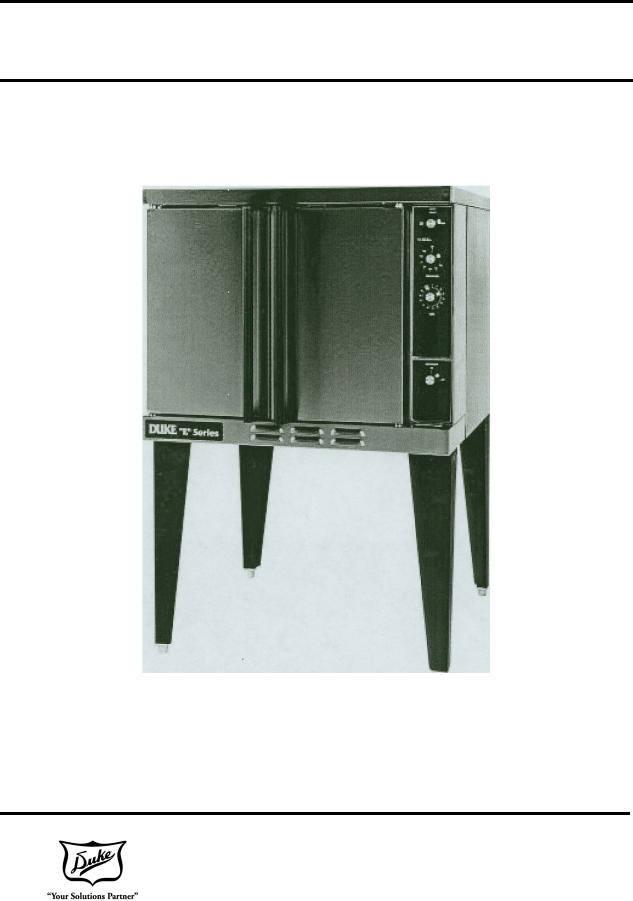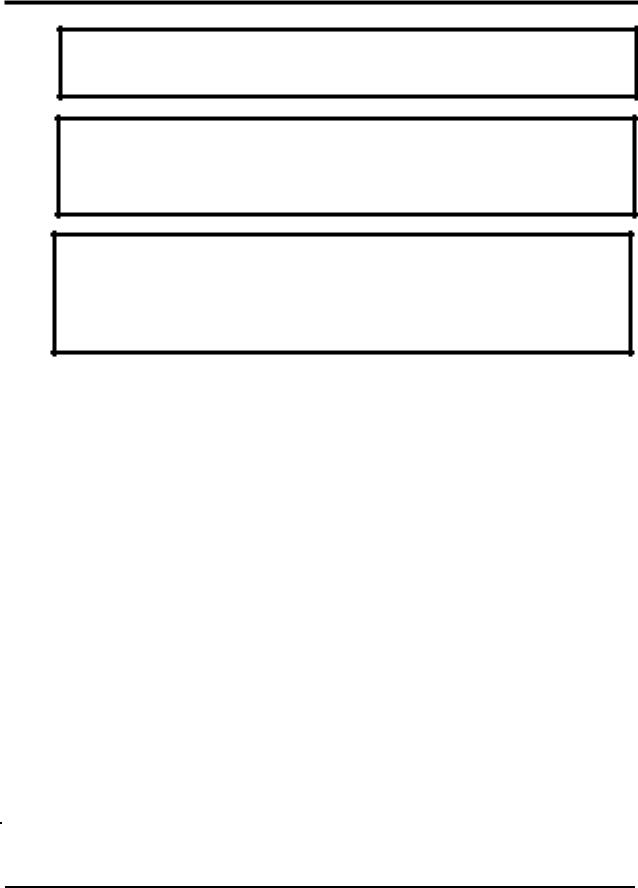Duke E101-EV Parts List

"E"Series
ELECTRIC CONVECTION OVEN
Installation, Operation, Parts
& Maintenance Manual
DUKE MANUFACTURING CO.
153431K
2305 N. Broadway • St. Louis, MO 63102
800.735.3853 • 314.231.1130 • 314.231.5074 Fax www.dukemfg.com

INDEX |
|
|
PAGE |
"E" Series Electric Specification |
3 |
Installation Instructions |
|
A. Qualified Personnel |
4 |
B. Delivery & Inspection |
4 |
C. Location of Oven |
4 |
D. Electrical Connections |
5 |
E. Ventilation |
5 |
F. Oven Assembly |
5 |
G Adjustments Associated with Installation |
6 |
Operating Instructions |
|
A. Oven Controls |
7 |
B. General Guidelines for Operation |
8 |
C. Suggested Times & Temperatures |
9 |
D. Cleaning the Oven |
10 |
Maintenance Instructions |
|
A. Adjustments |
10 |
B. Door Switch Adjustment |
10 |
C. Thermostat Calibration |
11 |
Repair Parts List |
12 |
Double Stacked Ovens |
13 |
Wiring Diagram |
14-15 |
Please supply the ID Number and the Serial Number when ordering replacement parts or requesting service.
We recommend service by Duke Authorized Service Agencies during and after the warranty period.
2

POST IN A PROMINENT LOCATION instructions to be followed in the event the user smells gas. This information shall be obtained by consulting the local gas supplier.
FOR YOUR SAFETY:
Do not store gasoline or other flammable vapors or liquids in the vicinity of this or any other appliance.
WARNING:
Improper installation, adjustment, alteration, service or maintenance can cause property damage, injury or death. Read the installation, operating and maintenance instructions thoroughly before installing or servicing this equipment.
“E” SERIES ELECTRIC CONVECTION OVEN
Electrical Specifications
TOTAL KW |
VOLTS |
1 PHASE |
3 PHASE |
|
|
|
|
10 KW |
208 |
53 |
31 |
|
|
|
|
10 KW |
240 |
46 |
27 |
|
|
|
|
10 KW |
220/380 |
|
20 |
|
|
|
|
10 KW |
240/415 |
|
18 |
|
|
|
|
10 KW |
480 |
|
14 |
|
|
|
|
3

INSTALLATION INSTRUCTIONS:
A. Qualified Personnel
These installation instructions are for the use of qualified installation and service personnel only. Installation or service by other than qualified personnel may result in damage to the oven and/or injury to the operator.
Qualified installation personnel are those individuals, firms, companies or corporations which either in person or through an agent are engaged in and responsible for:
• The installation of electrical wiring from the electric meter, main control box or service outlet to the electrical appliance. Qualified installation personnel must be familiar with all precautions required and have complied with all requirements of state and local authorities having jurisdiction. See: National Electrical Code, ANSI/NFPA70-1990.
B. Delivery and Inspection
Duke Manufacturing Co. does everything within its power to insure you received your oven in good condition. They are strapped down on heavy wooden skids and surrounded by heavy "tri-wall" cartons to prevent shipping damage. They have all been carefully inspected before they were packaged and consigned to the carrier.
Upon delivery of your Duke oven:
•Look over the shipping container, carefully noting any exterior damage on the delivery receipt which must also be signed by the driver/ delivery person.
•Uncrate and check for any damage which was not evident on the outside of the shipping container. This is called concealed damage. The carrier must be notified within fifteen (15) days of the delivery of the oven and the carton, skid and all packaging materials must be retained for inspection.
Duke Manufacturing Co. cannot assume liability for loss or damage suffered in transit. The carrier assumes full responsibility for delivery in good order when the
shipment was accepted. However, we are prepared to assist you in filing your claim.
C. Location of the Oven
Proper planning and placement of the oven will give you the best results in terms of long term user convenience and satisfactory performance. We urge you to give adequate thought in the placement of your oven prior to its arrival.
•The oven should be placed in an area which is free from drafts and accessible for proper operation and servicing.
•The area around the oven must be kept clear of combustible materials. A minimum clearance of:
|
Combustible |
Non- |
|
|
Combustible |
RIGHT SIDE |
1" |
0” |
LEFT SIDE |
1" |
0” |
REAR |
3" |
3” |
FLOOR |
8" |
8” |
must be maintained between the oven and any combustible or non-combustible surface
It is also improtant not to obstruct the natural flow of ventilation air if the oven is to operate properly. This oven should not be installed on a curb base or sealed to the wall. Either condition can restrict the flow of air to or prevent proper ventilation of the blower motor. The blower motor has a thermal protection device which will trip because of excessive ambient temperatures at the back of the oven. Theis condition should be corrected immediately to avoid damaging the oven permanently.
Before making any connections to the oven, heck the rating plate to be sure the oven specifications concur with the voltage and phase to be supplied to the oven
The rating plate is located behind the lower front panel. To access, loosen the four screws below the doors, and pull the panel outward.
The plate bearing the oven’s serial number is located on the right of the oven, below the control panel.
4

D. Electrical Connections
Your oven is supplied for connection to a 208, 240 or 480 volt grounded circuit. The electric motor, oven lights, indicator lights and control circuits are connected internally and require no seconday power supply
Before making any connections to these units, check the rating plate to assure that the voltage and phase of the oven is compatible with the electrical supply. When installing, all ovens must be electrically grounded in accordance with local codes, or in the absence of local codes, with the National Electrical Code, ANSI/NSPA 70-1990 (in Canada - CSA Std. C-22.1). Wiring diagrams are located in the control compartment area of the oven and at the back of the oven. Standard wiring schematics are also provided with this manual.
NOTE TO ELECTRICAL INSPECTOR:
Inspection of electrical connection should be accomplished by the removal of the lower finishing piece. This is done by loosing the four screws located in the door opening under the doors.
E. Ventilation
Proper ventilation is very important for the proper function of your oven. A good ventilation system will allow the oven to function properly as well as remove unwanted vapors. Not venting the ovens properly can result in unsatisfactory baking results as well as the possibility of damaging your oven. To keep your warranty in force, a proper ventilation system must be employed.
Venting to a Canopy Exhaust Hood
The best way to vent your oven is by placing it under a properly designed mechanically driven exhaust hood. The hood should be sized so the equipment which it is designed to ventilate fits underneath with a minimum six (6) inch (152 mm) overhang on all sides not adjacent to a wall. The distance from the floor to the lower edge of the canopy should not exceed seven (7) feet (2.2 m).
The hood should have adequate capacity and provide a sufficient supply of make up air. Ventilation hoods come in many sizes and capacities. Hood capacity is expressed in cubic feet per minute (CFM). The total make-up and exhaust air required for the canopy hood should be about 22 CFM per oven section. Information for the proper construction and installation of ventilating hoods may be obtained from the "Standard for the Installation of Equipment for the Removal of Smoke and Grease-Laden Vapors from Commercial
Cooking Equipment, NFPA-96-1980".
F. Oven Assembly
Before assembling and installing the oven, please check to make sure that all necessary parts are present. In addition to the oven itself, there will also be legs, feet or casters, the vent guard, (for double sectons, retaining clips vent riser) and miscellaneous hadware. Please check the interior of all oven sections for the parts needed to assemble and install your oven(s).
Leg Attachment
•Once the oven has been removed from the carton, lay it on its left side (the side without the controls), hold the leg and align with the threaded holes in the front comer of the bottom of the oven. Carefully start the threads of the comer leg bolt (5/16"-18 X 1/2"), avoid cross threading.
•Align the leg plate holes in each leg with those in the comers of the oven bottom and secure using two 5/ 16"-18 x 1/2" bolts. Tighten all bolts firmly. Repeat this procedure for all legs.
•Raise the oven up on its legs.
Level the oven by turning the adjustable feet in or out as needed.
Caster Installation
•Casters are available as an option for both the single and double oven sections.
•The installation of casters requires the removal of the adjustable feet from the legs. This is done by placing the bit of a large screwdriver against the lip of the foot and rapping the screwdriver to drive the foot out of the leg. The caster is then inserted fully into the opening where the foot came out and the locking nut tightened to expand the compression sleeve of the caster.
NOTE: The casters with locking brakes are best mounted on the front side of the oven for easier access.
If you plan to use casters, a fixed reatrant of the proper length is recommended to eliminate strain on the connecting wire. If the oven is revoed from its normal position, the restraint must then be reattached when returned.
5
